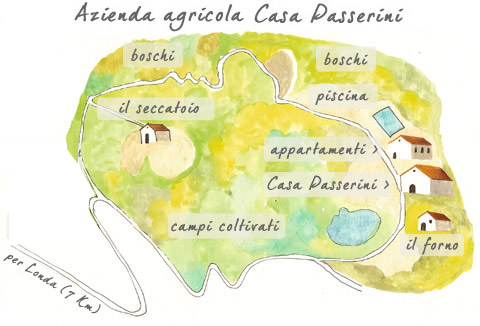Quiet Holidays in Tuscany
Quiet Holidays in Tuscany. Casa Passerini is immersed in verdant woodland and a stone’s throw from the Casentine Forests.
Quiet Holidays in Tuscany, The Farm
Organic barley, durum wheat and rape are grown on the 100 plus hectare farm of Casa Passerini. The terraced land around the villa l’Intento is used to cultivate olive trees that produce enough olive oil for the Manetti family and their guests.
The woods ensure a continuous source of work: Marco and his co-workers obtain enough fire wood for the farm, the families living in Londa and its neighbouring villages.
Alpine chamois goats and kids are reared on the farm. The surrounding landscape is home to all sorts of wild animals including deer, roe, porcupines and hares.

A Little History
Gianna, originally from Pontassieve (a small town about 20km from Londa) and Marcello, born in Fiesole (near Florence), married in 1973. Their passion for the countryside drew them to Londa, where they bought the villa l’Intento and the surrounding olive groves. And so renovation work began on the villa. The work was painstakingly long and slow and it was during this period that the villa served as a weekend retreat.
Marco was born in 1976 and four years later, once the restoration work had been completed, the Manetti family moved into the villa. Yet soon afterwards Marcello was chomping at the bit, dreaming that one day Casa Passerini and its land would be the family home. At that time Casa Passerini was an old wreck, but a wreck that was soon to come to life again.
Casa Passerini is an historic manor house built by Count Galli Tassi Passerini in 1620 as a country residence. Members of the Tassi Passerini family are very well known in Florence in that they married into the Medici family. Subsequently Casa Passerini passed into the ownership of the family of Count Ghezzi (a Florentine nobleman) and then the Gancia family of Turin who left the building to rack and ruin in 1960.
Between 1985 and 1986 Count Gancia resolved to put the Casa Passerini Estate up for sale. Marcello wasted no time and seized the opportunity. His dream had come true.
By 1986 the buildings were crumbling apart and in a poor state. Marcello, assisted by the able hands of family members, worked unstintingly on the renovation of the buildings. Over time the stone built outhouses regained all the semblance of their former glory and the farm was once again back on its feet.
In early 2000 some of the buildings on the Casa Passerini Farm were turned into guest accommodation for those staying on the farm and the manor house became home to Marcello, Gianna, Marco and Giulia.
A holiday at Casa Passerini is an unforgettable experience, as testified by Gianna and Marcello’s many friends who having spent a holiday there keep coming back year after year.
Torna all'inizio dei contenutiCalendar of Farm Activities
January
Firewood cutting and retail sale of firewood.
February
Firewood cutting and retail sale of firewood.
March
First hay cutting, pruning, cleaning of the fields and access roads. The kitchen garden is ploughed in preparation for sowing. The first kids are born sometime this month.
April
Hay making is in full swing with the cutting and baling of loose hay in hay presses. Sowing in the kitchen garden begins, the first asparagus are picked and more kids come to light.
May
Hay making continues (cutting and baling), tomatoes and salad greens are planted. The goats are milked.
June
Cherries are picked for jams as are mushrooms (Porcini and Gallinelle). Goat milking continues.
July
The threshing of wheat begins, hay making (cutting and baling) and goat milking continue. The kitchen garden produce (tomatoes, green beans, courgettes and other vegetables) are picked. The fields are ploughed and prepared for the sowing of wheat, barley and rape.
August
Tomato passata is made with the freshly picked tomatoes. Goat milking continues and blackberries are picked for jams. The firewood cut in the winter months is collected and removed. The fields continue to be ploughed.
September
The fields are ploughed, the goats milked and blackberries are picked for jam making. If it’s been raining we go mushroom picking. Renate and Rodolfo arrive, farmhouse habitués who’ve been coming for the last thirteen years.
October
Chestnuts are picked and are used to make chestnut jam.
November
We start cutting the firewood in the woods. Olives are harvested.
December
The firewood cutting continues and the olives are taken to the mill for processing.